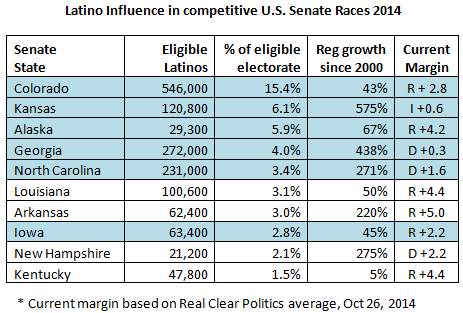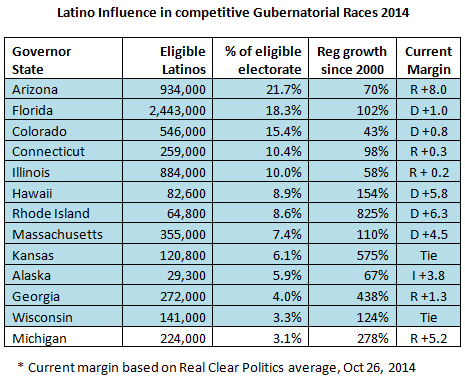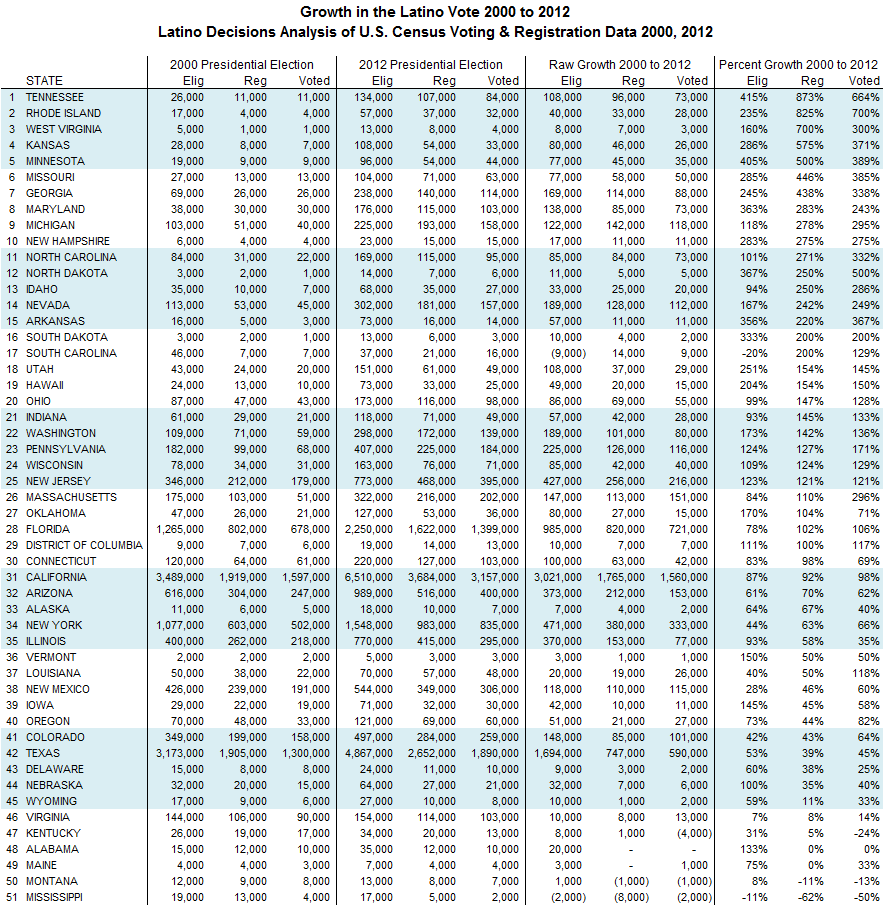The 2014 election is now just 8 days away and almost all the attention on the Latino vote is in Colorado’s Senate race. While other states with large Latino populations may not have competitive Senate races in 2014, the Latino population is not just a phenomenon in the Southwest. 14 years ago, the 2000 Census revealed quite clearly that the Latino population is spreading rapidly across the Southeast and Midwest. Including Colorado, there are six states in which the Latino share of the eligible electorate is larger than the current polling margin between the two candidates. Six States: Colorado, Kansas, Alaska, Georgia, North Carolina and Iowa. What’s more, many of these states are undergoing rapid population changes with Latino registered voters growing by 438% in Georgia and 575% in Kansas from the 2000 to 2012 presidential election, according to Census statistics. So these are states where we should continue to paying attention to the Latino vote in future statewide contests. We are not saying that Latinos will singly decide the 2014 Senate election across all six of these states, but rather that these states should be on your radar screen on November 4th.

However, voters are heading to the polls to elect more than U.S. Senators in 2014. There is a long list of competitive gubernatorial elections that will decide control of the Governor’s mansion in about a dozen states and the Latino population is large and growing across these states as well. Looking at competitive elections for Governor, there are 12 states where the share of Latino eligible voters is larger than the current polling margin between the two candidates. Some of these competitive states like Arizona and Rhode Island are now moving more towards the “leaning” column, but still have very large Latino electorates. But other states like Florida, Colorado, Connecticut and Illinois all have margins of 1% or less and Latino voting populations of 10% or more. Other states like Georgia and Kansas which small but growing Latino populations have competitive races for both Senate and Governor that could all be decided by less than 1%. Even the state of Wisconsin which is currently rated as a tie in the polls has a 3.3% Latino eligible electorate and has had 124% growth in Latino registered voters from 2000 to 2012.

Whether or not Latinos are part of the coalition that cast the deciding votes will depend largely on voter enthusiasm and voter turnout. In 2012 a record number of Latinos voted driven by strong enthusiasm for Obama’s executive order protecting DREAMers (DACA), combined with a robust Latino-focused get-out-the-vote effort by OFA, and uncoordinated, but equally strong efforts by national Latino civic groups dedicated to growing the Latino electorate. In 2014 Latinos could be the decisive vote in many of these 18 statewide races for Senate and Governor, but only if the campaigns activate, inspire and mobilize Latino voters. If that happens, we’ll all be talking about more than just Colorado on Wednesday November 5th.
Where the Latino vote is growing
The reasons more states than Colorado matter is that from 2000 to 2012 the number of Latino registered voters at least doubled in 28 states plus the District of Columbia (over 100% growth). Doubled in 12 years. This includes some large states like Florida where the number of Latino registered voters doubled from 802,000 in 2000 to 1,622,000 in 2012. Looking closer, in 17 of these states, the Latino vote at least tripled in 12 years (over 200% growth). And remarkable, there are 7 states in which the number of Latino registered voters increased by more than 400% in just 12 years. In Tennessee the number of Latino registered voters grew from 11,000 to 96,000 – an 873% growth rate from 2000 to 2012. In 2014, battleground states of Kansas and Georgia had 575% and 438% growth respectively. These dramatic trends are being driven by immigration flows 25 years ago in which many immigrants are now finally eligible and pursing naturalization and entering the electorate. Further, the number of U.S. born Latinos turning 18 and entering the electorate is increasing by the month. According to the National Council of La Raza, on average 70,000 U.S. born Latino citizens will turn 18 every single month and are eligible to vote. As these trends continue more and more states will enter the domain of Latino influence in elections for Governor, U.S. Senate and President.


